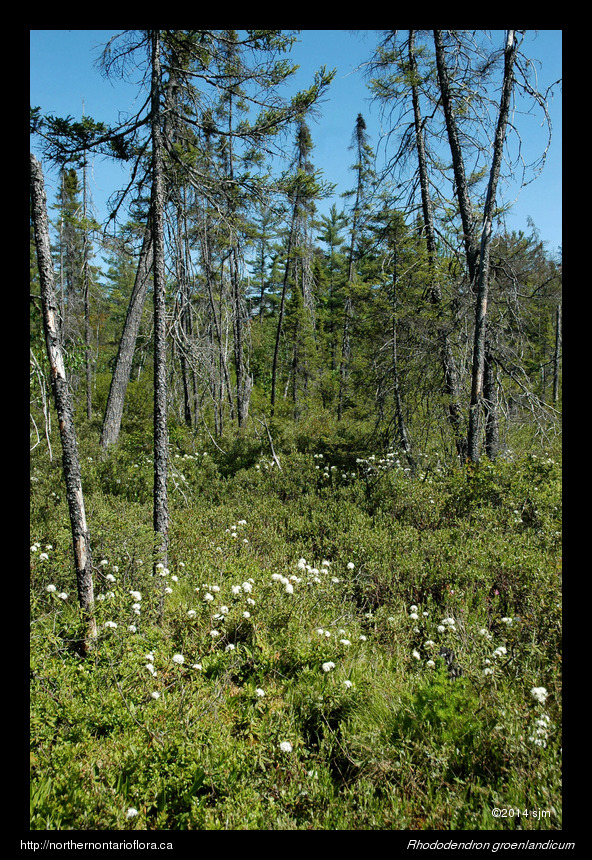
|
Northern Ontario Plant Database 
Plant DescriptionRhododendron groenlandicum (Oeder) Kron & JuddEn: common Labrador tea, Labrador tea, bog tea, rusty Labrador tea, Hudson Bay tea, woolly tea, settler's tea, tundra tea, Greenland Labrador tea, St. James tea
Ericaceae (Blueberry Family) Nomenclatural Notes: Labrador tea has long been known as Ledum groenlandicum Oeder, but the genus Ledum was recently included within the genus Rhododendron. To learn more about about the nomenclatural changes in other Ledum species, see the articles by Kron & Judd (1990) and Harmaja (1990, 1991), referenced below. General: A low open evergreen shrub, to 1 m tall. Stems/twigs: Young twigs are densely pubescent with woolly white hairs that turn cinnamon-brown as the stem matures; older stems are greyish-brown and become smooth (glabrate). The large terminal flower buds are ovoid, blunt, pinkish-red, and scaly. Leaves: Alternate, simple, evergreen, fragrant when crushed, and short-petiolate. Leaf blades are narrowly elliptic to oblong-elliptic, 2—5 cm long by 0.5—2 cm wide, leathery-textured (coriaceous), dull and dark green above, with the lower leaf surface densely covered in matted woolly hairs that turn from white to rusty-brown at maturity. Leaf bases and apices are blunt (obtuse); margins are entire and turned under (revolute). Over winter, leaves turn dark browish-green to bronze. Flowers: Bisexual; several flowers occur in showy rounded umbel-like terminal inflorescences. Individual flowers are about 1 cm across; the calyx is small and 5-toothed; the corolla is composed of 5 white ovate to oblong petals, fused at the base. Stamens number 5—7 and the filaments are longer than the petals; the compound pistil has a finely-hairy superior ovary of 5 carpels and a single prominent style that persists in fruit. Flowers blooms in June to early July. Fruit: The fruits (capsules) are reddish and finely hairy (pubescent) when young, but become dry and reddish brown at maturity. The small 5-chambered capsules split (dehisce) from the base upwards to release seeds; each pendant capsule resembles a small partially-open umbrella on a slender recurved stalk (pedicel) and is topped by a persistent style. Old clusters of capsules often persist for a few years, but are exceeded by lateral branches that form below the inflorescence and elongate beyond each flowering branch. Habitat and Range: Moist to wet peaty soils, especially in bogs and wet coniferous forests; also in wet roadsides, rights-of-way, and peaty barrens. Labrador tea is native to boreal North America and occurs in every Province of Canada; its range extends across Ontario and throughout the Algoma District. Similar Species: In Ontario, northern Labrador tea (Rhododendron tomentosum Harmaja), also known as dwarf Labrador tea or muskeg tea, occurs only in the Hudson Bay and James Bay regions of northern Ontario. This species was formerly known as either Ledum decumbens (Aiton) Lodd. ex Steud. or Ledum palustre L. Northern Labrador tea can be distinguished from our common Labrador tea by its smaller height, to 5 dm tall, and its narrow, linear, more wrinkled leaves, to 1.5 cm long by 1—3 mm wide. Bog laurel (Kalmia polifolia Wangenh.) often grows in the same habitat as Labrador tea, but is generally smaller and can be distinguished by its open pink flowers and opposite dark green leaves that are glabrous to glossy, narrower, and white beneath with slightly revolute margins. The glaucous bog rosemary (Andromeda polifolia L. var. latifolia Aiton) has similar leaves, but these are alternate, often bluish-green and somewhat glaucous, with a dull leaf surface and several pale impressed veins. Leaves near the branch tips are held upright, arching over the nodding clusters of small rounded pinkish-white flowers. References: Harmaja, H. 1990. New names and nomenclatural combinations in Rhododendron (Ericaceae). Ann. Bot. Fenn. 27:203—204. Harmaja, H. 1991. Taxonomic notes on Rhododendron subsection Ledum (Ledum, Ericaceae), with a key to its species. Ann. Bot. Fenn. 28:171-173. Kron, K.A. & W.S. Judd. 1990. Phylogenetic relationships within the Rhodoreae (Ericaceae) with specific comments on the placement of Ledum. Syst. Bot. 15: 57-68. Back to species list |
||||||||||||||||||||||






















